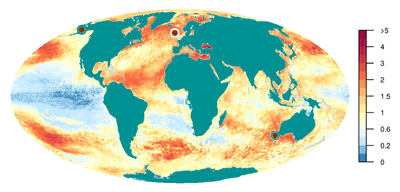Human impact on marine life
Human activities affect marine life and marine habitats through overfishing, pollution, acidification and the introduction of invasive species. These impact marine ecosystems and food webs and may result in consequences as yet unrecognised for the biodiversity and continuation of marine life forms.[3]
Overfishing
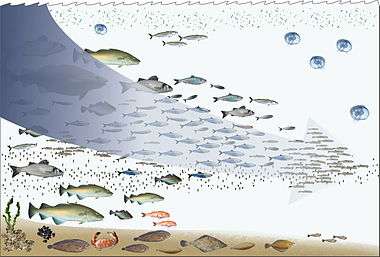
Overfishing of high trophic fish like tuna can result in
them being replaced by low trophic organisms, like jellyfish
– Daniel Pauly, pioneer on human impacts on global fisheries, [4]
Overfishing is occurring in one third of world fish stocks, according to a 2018 report by the Food and Agriculture Organization of the United Nations.[5] In addition, industry observers believe illegal, unreported and unregulated fishing occurs in most fisheries, and accounts for up to 30% of total catches in some important fisheries.[6] In a phenomenon called fishing down the foodweb, the mean trophic level of world fisheries has declined because of overfishing high trophic level fish.[7]
Marine pollution
Marine pollution results from the entry into the ocean of industrial, agricultural, and residential wastes.[8] Pathways for this pollution include agricultural runoff into rivers and wind-blown debris and dust.
Nutrient pollution
Nutrient pollution is a primary cause of eutrophication of surface waters, in which excess nutrients, usually nitrates or phosphates, stimulate algae growth.
Toxic chemicals
Toxic chemicals can adhere to tiny particles which are then taken up by plankton and benthic animals, most of which are either deposit feeders or filter feeders. In this way, toxins are concentrated upward within ocean food chains. Many particles combine chemically in a manner which depletes oxygen, causing estuaries to become anoxic. Pesticides and toxic metals are similarly incorporated into marine food webs, harming the biological health of marine life. Many animal feeds have a high fish meal or fish hydrolysate content. In this way, marine toxins are transferred back to farmed land animals, and then to humans.
Phytoplankton concentrations have increased over the last century in coastal waters, and more recently have declined in the open ocean. Increases in nutrient runoff from land may explain the increases in coastal phytoplankton, while warming surface temperatures in the open ocean may have strengthened stratification in the water column, reducing the flow of nutrients from the deep that open ocean phytoplankton find useful.[9]
Plastic pollution
| Part of a series of overviews on |
| Marine life |
|---|
|
|
|
Estimates suggest something like 9 million tonnes of plastic is added to the ocean every year. This plastic may need 450 years or more to biograde. Once in the ocean, plastics are shredded by marine amphipods into microplastics. There are now beaches where 15 percent of the sand are grains of microplastic. In the oceans themselves, microplastics float in surface waters amongst the plankton where they are ingested by plankton eaters.[10]
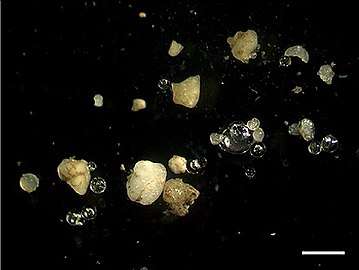 Microplastics among sand and glass spheres in sediment from the Rhine. The white bar represents 1 mm.
Microplastics among sand and glass spheres in sediment from the Rhine. The white bar represents 1 mm. Vast plastic garbage patches have accumulated at the centre of ocean gyres.[11]
Vast plastic garbage patches have accumulated at the centre of ocean gyres.[11]
Noise pollution
Underwater noise pollution due to human activities is also prevalent in the sea.[12] Cargo ships generate high levels of noise due to propellers and diesel engines.[13][14] This noise pollution significantly raises the low-frequency ambient noise levels above those caused by wind.[15] Animals such as whales that depend on sound for communication can be affected by this noise in various ways. Even marine invertebrates, such as crabs (Carcinus maenas), have been shown to be negatively affected by ship noise.[16][17]
Ocean acidification
.png)
Ocean acidification is the increasing acidification of the oceans, caused by the uptake of carbon dioxide from the atmosphere.[18] The rise in atmospheric carbon dioxide due to the burning of fossil fuels leads to more carbon dioxide dissolving in the ocean. When carbon dioxide dissolves in water it forms hydrogen and carbonate ions. This in turn increases the acidity of the ocean and makes survival increasingly harder for shellfish and other marine organisms that depend on calcium carbonate to form their shells.[19]

Increasing acidity is also thought to have a range of potentially harmful consequences for marine organisms, such as depressing metabolic rates and immune responses in some organisms, and causing coral bleaching.[20] Ocean acidification has increased 26% since the beginning of the industrial era.[21] It has been compared to anthropogenic climate change and called the "evil twin of global warming"[22] and "the other CO
2 problem".[23]
The map on the right shows changes in the aragonite saturation level of ocean surface waters between the 1880 and 2012. Aragonite is a form of calcium carbonate that many marine animals use to build their skeletons and shells. The lower the saturation level, the more difficult it is for organisms to build and maintain their skeletons and shells. A negative change represents a decrease in saturation.[24]
Microorganisms
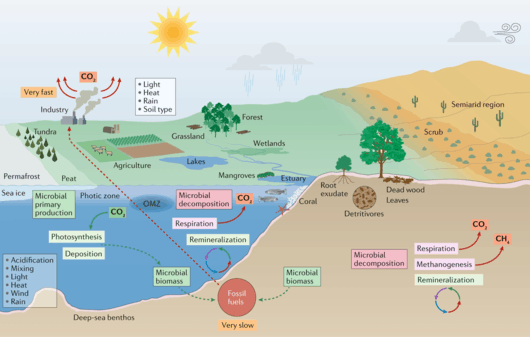
In marine environments, microbial primary production contributes substantially to CO2 sequestration. Marine microorganisms also recycle nutrients for use in the marine food web and in the process release CO2 to the atmosphere. Microbial biomass and other organic matter (remnants of plants and animals) are converted to fossil fuels over millions of years. By contrast, burning of fossil fuels liberates greenhouse gases in a small fraction of that time. As a result, the carbon cycle is out of balance, and atmospheric CO2 levels will continue to rise as long as fossil fuels continue to be burnt.[25]
Invasive species

An invasive species is a species not native to a particular location which can spread to a degree that causes damage to the environment, human economy or human health.[26] In 2008, Molnar et al. documented the pathways of hundreds of marine invasive species and found shipping was the dominant mechanism for the transfer of invasive species in the ocean. The two main maritime mechanisms of transporting marine organisms to other ocean environments are via hull fouling and the transfer of ballast water.[27]
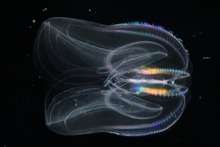
Ballast water taken up at sea and released in port is a major source of unwanted exotic marine life. The invasive freshwater zebra mussels, native to the Black, Caspian, and Azov seas, were probably transported to the Great Lakes via ballast water from a transoceanic vessel.[28] Meinesz believes that one of the worst cases of a single invasive species causing harm to an ecosystem can be attributed to a seemingly harmless jellyfish. Mnemiopsis leidyi, a species of comb jellyfish that spread so it now inhabits estuaries in many parts of the world, was first introduced in 1982, and thought to have been transported to the Black Sea in a ship's ballast water. The population of the jellyfish grew exponentially and, by 1988, it was wreaking havoc upon the local fishing industry. "The anchovy catch fell from 204,000 tons in 1984 to 200 tons in 1993; sprat from 24,600 tons in 1984 to 12,000 tons in 1993; horse mackerel from 4,000 tons in 1984 to zero in 1993."[29] Now that the jellyfish have exhausted the zooplankton, including fish larvae, their numbers have fallen dramatically, yet they continue to maintain a stranglehold on the ecosystem.
Invasive species can take over once occupied areas, facilitate the spread of new diseases, introduce new genetic material, alter underwater seascapes, and jeopardize the ability of native species to obtain food. Invasive species are responsible for about $138 billion annually in lost revenue and management costs in the US alone.[30]
Habitat loss
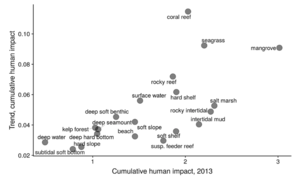
Coastal ecosystems are being damaged by many ways by humans.[31] Habitat loss is occurring in seagrass meadows, mangrove forests, coral reefs and kelp forests, all of which are in global decline due to human disturbances.
Seagrass meadows have lost 30,000 km2 (12,000 sq mi) during recent decades. Seagrass ecosystem services, currently worth about $US1.9 trillion per year, include nutrient cycling, the provision of food and habitats for many marine animals, including the endangered dugongs, manatee and green turtles, and major facilitations for coral reef fish.[31]
One fifth of the world's mangrove forests have been lost since 1980,[32] and another fifth of coral reefs have been lost.[33] The most pressing threat to kelp forests may be the overfishing of coastal ecosystems, which by removing higher trophic levels facilitates their shift to depauperate urchin barrens.[34]
Silicates
The rise in agriculture of the past 400 years has increased the exposure rocks and soils, which has resulted in increased rates of silicate weathering. In turn, the leaching of amorphous silica stocks from soils has also increased, delivering higher concentrations of dissolved silica in rivers.[35] Conversely, increased damming has led to a reduction in silica supply to the ocean due to uptake by freshwater diatoms behind dams. The dominance of non-siliceous phytoplankton due to anthropogenic nitrogen and phosphorus loading and enhanced silica dissolution in warmer waters has the potential to limit silicon ocean sediment export in the future.[35]
Shifting baselines
Shifting baselines arise in research on marine ecosystems because changes must be measured against some previous reference point (baseline), which in turn may represent significant changes from an even earlier state of the ecosystem.[36] For example, radically depleted fisheries have been evaluated by researchers who used the state of the fishery at the start of their careers as the baseline, rather than the fishery in its unexploited or untouched state. Areas that swarmed with a particular species hundreds of years ago may have experienced long term decline, but it is the level a few decades previously that is used as the reference point for current populations. In this way large declines in ecosystems or species over long periods of time were, and are, masked. There is a loss of perception of change that occurs when each generation redefines what is natural or untouched.[36]
See also
- Anthropocene
- Climate change and ecosystems
- Effects of global warming on marine mammals
- Marine debris
- Threatened rays
- Threatened sharks
References
- Halpern, B.S., Frazier, M., Afflerbach, J. et al. (2019) "Recent pace of change in human impact on the world’s ocean." Nature Scientific Reports, 9: 11609. doi:10.1038/s41598-019-47201-9
- Halpern, B.S., Walbridge, S., Selkoe, K.A., Kappel, C.V., Micheli, F., D'agrosa, C., Bruno, J.F., Casey, K.S., Ebert, C., Fox, H.E. and Fujita, R. (2008) "A global map of human impact on marine ecosystems". Science, 319(5865): 948–952. doi:10.1126/science.1149345
- Human impacts on marine ecosystems GEOMAR Helmholtz Centre for Ocean Research. Retrieved 22 October 2019.
- Pauly, Daniel. Fisheries on the brink (YouTube video). Retrieved 1 May 2012.
- fao.org. "SOFIA 2018 - State of Fisheries and Aquaculture in the world 2018". www.fao.org. Retrieved 9 November 2018.
- World Wildlife Fund. "Fishing problems: Illegal fishing" Archived 2008-04-11 at the Wayback Machine
- Pauly, Daniel and Watson, Reg (2009) "Spatial Dynamics of Marine Fisheries" Archived 2012-06-11 at the Wayback Machine In: Simon A. Levin (ed.) The Princeton Guide to Ecology. Pages 501–509.
- US Department of Commerce, National Oceanic and Atmospheric Administration. "What is the biggest source of pollution in the ocean?". oceanservice.noaa.gov. Retrieved 22 November 2015.
- Boyce, D.G. and Worm, B. (2015) "Patterns and ecological implications of historical marine phytoplankton change". Marine Ecology Progress Series, 534:251–272. doi:10.3354/meps11411
- Parker, Laura (2018) "We made plastic. We depend on it. Now we're drowning in it". National Geographic.
- "Great Pacific Garbage Patch". Marine Debris Division – Office of Response and Restoration. NOAA. 11 July 2013. Archived from the original on 17 April 2014.
- Williams, R., Wright, A.J., Ashe, E., Blight, L.K., Bruintjes, R., Canessa, R., Clark, C.W., Cullis-Suzuki, S., Dakin, D.T., Erbe, C. and Hammond, P.S. (2015) "Impacts of anthropogenic noise on marine life: Publication patterns, new discoveries, and future directions in research and management". Ocean & Coastal Management, 115: 17–24. doi:10.1016/j.ocecoaman.2015.05.021
- Arveson, Paul T; Vendittis, David J (2000). "Radiated noise characteristics of a modern cargo ship". The Journal of the Acoustical Society of America. 107 (1): 118–129. Bibcode:2000ASAJ..107..118A. doi:10.1121/1.428344. PMID 10641625.
- McKenna, Megan F; Ross, Donald; Wiggins, Sean M; Hildebrand, John A (2011). "Measurements of radiated underwater noise from modern merchant ships relevant to noise impacts on marine mammals". The Journal of the Acoustical Society of America. 129 (4): 2368. Bibcode:2011ASAJ..129.2368M. doi:10.1121/1.3587665.
- Wenz, Gordon M (1962). "Acoustic Ambient Noise in the Ocean: Spectra and Sources". The Journal of the Acoustical Society of America. 34 (12): 1936–1956. Bibcode:1962ASAJ...34.1936W. doi:10.1121/1.1909155.
- McClain, Craig (3 April 2013). "Loud Noise Makes Crabs Even More Crabby". Deep Sea News. Retrieved 4 April 2013.
- Wale, M. A.; Simpson, S. D.; Radford, A. N. (2013). "Size-dependent physiological responses of shore crabs to single and repeated playback of ship noise". Biology Letters. 9 (2): 20121194. doi:10.1098/rsbl.2012.1194. ISSN 1744-9561. PMC 3639773. PMID 23445945.
- Caldeira, K.; Wickett, M. E. (2003). "Anthropogenic carbon and ocean pH". Nature. 425 (6956): 365. Bibcode:2001AGUFMOS11C0385C. doi:10.1038/425365a. PMID 14508477.
- (Trujillo & Thurman 2008, p. 151)
- Anthony, KRN; et al. (2008). "Ocean acidification causes bleaching and productivity loss in coral reef builders". Proceedings of the National Academy of Sciences. 105 (45): 17442–17446. Bibcode:2008PNAS..10517442A. doi:10.1073/pnas.0804478105. PMC 2580748. PMID 18988740.
- IPCC (2019) Summary for Policymakers. In: IPCC Special Report on the Ocean and Cryosphere in a Changing Climate, Chapter 1, page 14. [H.O. Pörtner, D.C. Roberts, V. Masson-Delmotte, P. Zhai, M. Tignor, E. Poloczanska, K. Mintenbeck, M. Nicolai, A. Okem, J. Petzold, B. Rama, N. Weyer (eds.)]. Final draft: 24 September 2019.
- "Ocean Acidification Is Climate Change's 'Equally Evil Twin,' NOAA Chief Says". Huffington Post. 9 July 2012. Archived from the original on 12 July 2012. Retrieved 9 July 2012.
- Doney, S.C. (2009). "Ocean Acidification: The Other CO
2 Problem". Annual Review of Marine Science. 1: 169–192. Bibcode:2009ARMS....1..169D. doi:10.1146/annurev.marine.010908.163834. PMID 21141034. - Woods Hole Oceanographic Institution (August 2016). "Changes in Aragonite Saturation of the World's Oceans, 1880–2015". epa.gov.
- Cavicchioli, R., Ripple, W.J., Timmis, K.N., Azam, F., Bakken, L.R., Baylis, M., Behrenfeld, M.J., Boetius, A., Boyd, P.W., Classen, A.T. and Crowther, T.W. (2019) "Scientists’ warning to humanity: microorganisms and climate change". Nature Reviews Microbiology, 17: 569–586. doi:10.1038/s41579-019-0222-5
- Joan G. Ehrenfeld (2010), "Ecosystem Consequences of Biological Invasions", Annual Review of Ecology, Evolution, and Systematics, 41: 59–80, doi:10.1146/annurev-ecolsys-102209-144650
- Molnar, Jennifer L; Gamboa, Rebecca L; Revenga, Carmen; Spalding, Mark D (2008). "Assessing the global threat of invasive species to marine biodiversity". Frontiers in Ecology and the Environment. 6 (9): 485–492. doi:10.1890/070064. ISSN 1540-9295.
- Aquatic invasive species. A Guide to Least-Wanted Aquatic Organisms of the Pacific Northwest Archived 25 July 2008 at the Wayback Machine. 2001. University of Washington
- Meinesz, A. (2003) Deep Sea Invasion: The Impact of Invasive Species PBS: NOVA. Retrieved 26 November 2009
- Pimentel, D.; Zuniga, R.; Morrison, D. (2005). "Update on the environmental and economic costs associated with alien-invasive species in the United States". Ecological Economics. 52 (3): 273–288. doi:10.1016/j.ecolecon.2004.10.002.
- Waycott, M., Duarte, C.M., Carruthers, T.J., Orth, R.J., Dennison, W.C., Olyarnik, S., Calladine, A., Fourqurean, J.W., Heck, K.L., Hughes, A.R. and Kendrick, G.A. (2009) "Accelerating loss of seagrasses across the globe threatens coastal ecosystems". Proceedings of the national academy of sciences, 106(30): 12377–12381. doi:10.1073/pnas.0905620106
- "2010a. ""World Atlas of Mangroves" Highlights the Importance of and Threats to Mangroves: Mangroves among World's Most Valuable Ecosystems." Press release. Arlington, Virginia". The Nature Conservancy. Archived from the original on 17 July 2010. Retrieved 25 January 2014.
- Wilkinson, Clive (2008) Status of Coral Reefs of the World: Executive Summary. Global Coral Reef Monitoring Network.
- Sala, E., C.F. Bourdouresque and M. Harmelin-Vivien. 1998. Fishing, trophic cascades, and the structure of algal assemblages: evaluation of an old but untested paradigm. Oikos 82: 425-439.
- Gaillardet, J.; Dupré, B.; Louvat, P.; Allègre, C.J. (July 1999). "Global silicate weathering and CO2 consumption rates deduced from the chemistry of large rivers". Chemical Geology. 159 (1–4): 3–30. Bibcode:1999ChGeo.159....3G. doi:10.1016/s0009-2541(99)00031-5. ISSN 0009-2541.
- Pauly, Daniel (1995) "Anecdotes and the shifting baseline syndrome of fisheries". Trends in ecology & evolution, 10(10): 430.
